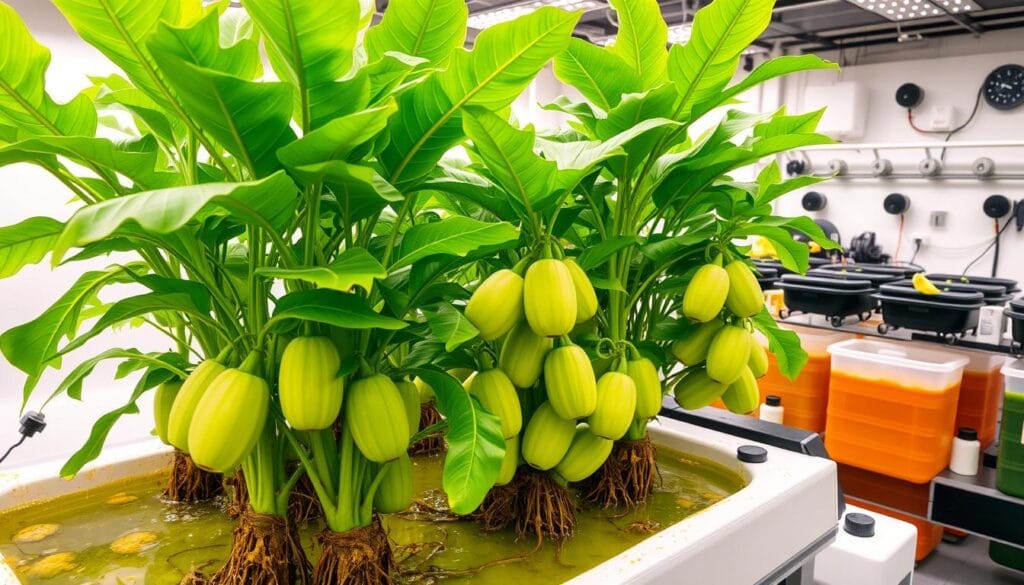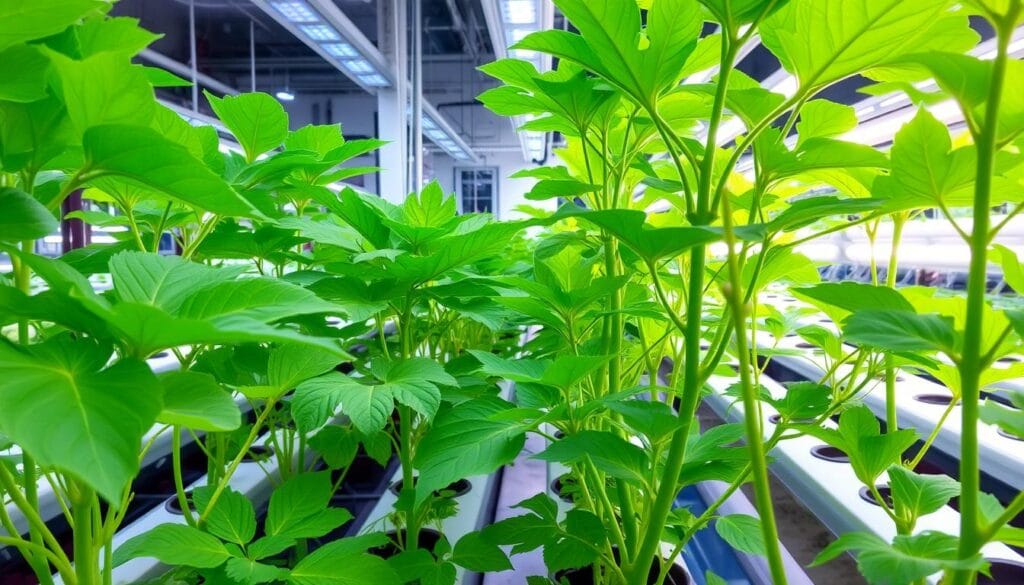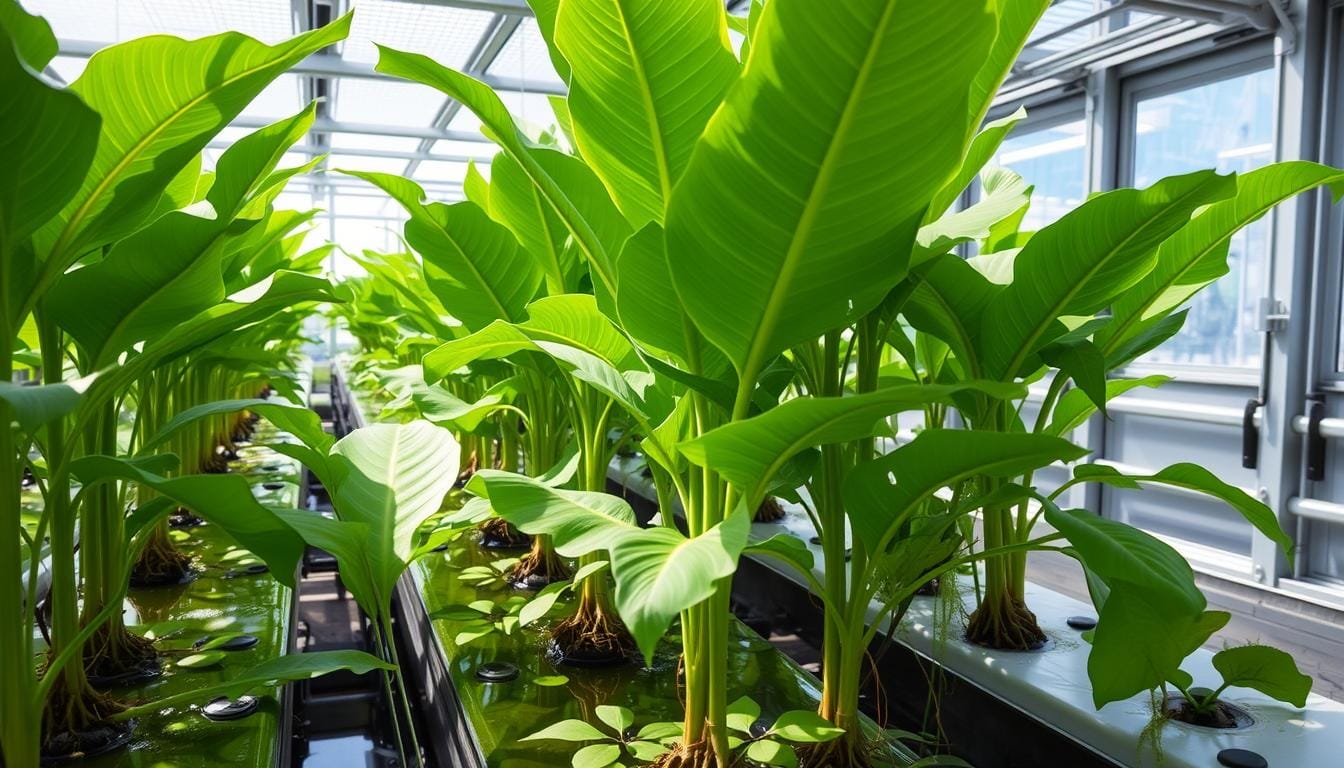Musa hydroponic cultivation offers a unique and rewarding way to grow lush banana plants. Standing in my backyard, I felt wonder and pride as I admired the swaying banana plants thriving in their hydroponic setup. These tips will help you grow Musa plants successfully, whether new or experienced.
Key Takeaways
- Discover the unique benefits of growing musa (banana) plants hydroponically
- Learn essential cultivation techniques for optimal growth and fruit production
- Understand the botanical structure and natural habitat requirements of musa plants
- Explore the key components of a successful music hydroponic system
- Enhance your knowledge of Musa nutrition, water management, and pest control strategies
Understanding Musa Plants and Their Growth Requirements
Musa plants, also known as banana plants, belong to the Musaceae family. They love warm, humid places and grow best between 60°F and 80°F. Banana plants need lots of sunlight, at least 6 to 8 hours a day, to grow well and produce fruit.
Botanical Structure and Classifications
Banana plants are tall, flowering perennials that can grow up to 20 feet. They do best in USDA Hardiness Zones 9-11, perfect for tropical and subtropical areas. These plants have a special growth pattern, with a pseudostem and a hidden true stem underground.
Natural Habitat Conditions
Banana plants love fertile, moist loamy soil with a pH between 5.5 and 7. They do well in places with steady, moderate rain and high humidity. Planting them 8 feet apart helps them grow and produce fruit well in controlled environments.
Growth Cycles and Development Stages
The banana plant goes through several stages: vegetative, flowering, and fruiting. Under the right conditions, they can produce fruit in their first year. The fruit grows in clusters called “hands,” with each banana being a “finger.” Keeping an eye on these stages is key to growing lots of tropical fruit in controlled environments.
| Growth Media | Germination Rate |
|---|---|
| Rockwool | 71.0% |
| Moss Sphagnum | 66.33% |
| Cocopeat | 64.67% |
| Sand, Charcoal Husk, Farmer’s Planting Media, Manure Compost + Soil | Lower Rates |
Knowing about Musa plants’ structure, habitat, and growth helps growers improve their tropical fruit production in controlled environments.
Essential Components of a Musa Hydroponic System
Growing bananas (Musa spp.) hydroponically needs a well-thought-out system. It must offer the best conditions for their growth. A good system includes a strong water-based crop systembiodigesterfertilizer for nutrients, a good lighting setup, and control over temperature and humidity. It also needs support for the plants to grow.
The heart of any hydroponic system is the nutrient delivery. The nutrient film technique (NFT) ensures the roots get the nutrients they need. It’s important to keep an eye on the solution’s pH and electrical conductivity (EC) levels. This helps keep the plants in the best growing environment.
| Component | Requirement |
|---|---|
| Nutrient Delivery System | Robust, utilizing the nutrient film technique (NFT) for constant nutrient supply |
| Lighting Setup | Adequate intensity and spectrum to support photosynthesis and growth |
| Temperature and Humidity Control | Maintaining optimal temperature and humidity levels for Musa plant development |
| Plant Support Structures | Sturdy trellises or frames to guide the plant’s growth and ensure stability |
The growing medium, like coconut coir or perlite, should be a soilless substrate. It needs to be airy and hold the right amount of moisture. This is key for the plant’s health and how well it grows.
By focusing on these key parts, growers can make a Musa hydroponic system thrive. This ensures a good harvest.
Creating the Optimal Environmental Conditions
To grow vertical farming or controlled environment agriculture systems for Musa (banana) plants, you need to focus on their environmental needs. These tropical plants love warm, humid places. The ideal temperature range for musa plants is 60°F to 80°F, with a preferred humidity level of 70% to 90%. It’s also important to have good airflow to keep them healthy.
Temperature Control Methods
To keep the temperature right in a hydroponic Musa setup, you can use heaters and air conditioners. Some systems even have special climate control tools. This ensures the plants maintain an optimal temperature for healthy growth.
Humidity Management Techniques
- Misting systems: These add fine water droplets to the air, raising humidity.
- Evaporative coolers: They cool the air and add moisture.
- Dehumidifiers: These remove extra moisture to keep humidity in check.
Light Requirements and Solutions
Musa plants need lots of light, at least 6-8 hours a day. In vertical farming or controlled environment agriculture setups, you can use strong grow lights. These can be HID or LED lights. They help make sure the plants get enough light to grow well and produce fruit.
| Environmental Factor | Optimal Range | Control Methods |
|---|---|---|
| Temperature | 60°F – 80°F | Heating and cooling systems, automated climate control |
| Humidity | 70% – 90% | Misting systems, evaporative coolers, dehumidifiers |
| Light | 6-8 hours of direct sunlight or equivalent artificial lighting | HID or LED grow lights |
Musa Hydroponic Nutrition Management
Keeping the right balance of nutrients is key for growing Musa plants in hydroponics. A good nutrient solution should have the right mix of macronutrients like nitrogen, phosphorus, and potassium. It also needs essential micronutrients like iron, manganese, and zinc.
The electrical conductivity (EC) of the solution must be watched closely. It needs to be higher when plants are growing fast and lower when they’re producing fruit. Fertilizing every 4-6 weeks helps keep nutrients flowing for healthy growth.
Liquid fertilizers are best for hydroponics because they mix well and spread evenly. Using biostimulants and plant growth-promoting bacteria (PGPB) can also help. They boost nutrient uptake and plant health, cutting down on synthetic fertilizers.
| Nutrient | Role in Musa Plants | Recommended Levels |
|---|---|---|
| Nitrogen (N) | Promotes vegetative growth, leaf development, and photosynthesis | 150-200 ppm |
| Phosphorus (P) | Supports root growth, flowering, and fruit development | 40-60 ppm |
| Potassium (K) | Enhances drought tolerance, disease resistance, and fruit quality | 300-400 ppm |
| Iron (Fe) | Crucial for chlorophyll production and photosynthesis | 2-4 ppm |
| Manganese (Mn) | Involved in enzyme activation and photosynthesis processes | 0.5-1.0 ppm |
| Zinc (Zn) | Plays a role in plant growth, development, and stress tolerance | 0.3-0.6 ppm |
By managing nutrients well and using sustainable methods, hydroponic Musa growers can improve plant health. This leads to better quality and yield in their farming.

Water Quality and Irrigation Strategies
Keeping water quality high is key in soilless farming and hydroponic systems like growing Musa plants. The pH levels need to be between 5.5 and 6.5 for good nutrient uptake. Also, check the electrical conductivity (EC) regularly to ensure the right nutrient mix for your plants.
Watering is vital for Musa plants in hydroponics. Water them often but don’t let the system get too wet. Drip irrigation or the Nutrient Film Technique (NFT) are good methods. They give the roots a steady flow of nutrients without flooding the system.
pH and EC Monitoring
It’s important to keep an eye on pH and EC levels for your Musa plants. The pH should be between 5.5 and 6.5 for best nutrient absorption. Adjust the EC levels to keep the nutrient concentration right in the water.
Watering Schedules and Techniques
Watering often is crucial for Musa plants in hydroponics, but avoid too much water. Drip irrigation or NFT are good choices. They give the roots a steady flow of nutrients without flooding the system. Also, keep the water temperature between 68-72°F for the best results.
Common Water-Related Issues
Root rot is a big problem in hydroponic Musa growing, often from too much water and bad drainage. Nutrient imbalances can also cause stunted growth or color changes in your banana plants. Watch your water quality closely and adjust your watering to avoid these issues.
| Metric | Optimal Range | Potential Issues |
|---|---|---|
| pH | 5.5 – 6.5 | Nutrient deficiencies, poor nutrient uptake |
| EC (Electrical Conductivity) | 1.2 – 2.4 mS/cm | Nutrient imbalances, toxicity, stunted growth |
| Water Temperature | 68 – 72°F | Slowed growth, root issues |
Disease Prevention and Plant Health Management
In urban agriculture and controlled environment agriculture, stopping diseases is key. Look for pests like aphids, spider mites, and mealybugs often. Use Integrated Pest Management (IPM) to keep plants healthy and stop disease spread.
Good air flow helps prevent fungal diseases. Clean your tools and keep new plants separate to stop disease spread.
Harnessing Beneficial Microbes
Studies show that certain microbes can help plants grow better and fight off diseases. For example, Ochrobactrum sp. MC22 can make plants grow well in polluted areas. Enterobacter species help plants grow strong under stress.
Pseudomonas species fight off diseases with special chemicals and help plants grow. Streptomyces spp. also fight fungal diseases and are good for plant health.
| Beneficial Microbe | Key Attributes |
|---|---|
| Ochrobactrum sp. MC22 | Improved yields in contaminated areas, rhizoremediation potential |
| Enterobacter species | Stimulate root branching and plant growth under stress conditions |
| Pseudomonas species | Produce secondary metabolites, enhance plant growth through IAA biosynthesis |
| Streptomyces spp. | Biocontrol activities against fungal diseases, recommended for plant disease control |
Using these microbes can make plants healthier, fight off diseases, and improve your urban agriculture and controlled environment agriculture systems.

Maximizing Fruit Production in Hydroponic Systems
To get the most out of your tropical fruit production, focus on the flowering and fruiting stages. Managing these stages well ensures a good harvest. It also makes your hydroponic setup work better.
Flowering Stage Management
Good care in the flowering stage is key for a fruitful season. Make sure your plants have the right temperature, humidity, and light. This helps flowers grow strong.
Keep an eye on these factors and adjust them as needed. This can really help your plants bloom as they should.
Fruit Development Support
When plants start growing fruit, they need support. Prune off extra leaves and suckers to help them focus on fruit. This makes the fruit bigger and better.
Also, use trellises or stakes to keep stems from breaking. This keeps the fruit bunches safe and supported.
Harvesting Guidelines
Harvesting at the right time is important. Pick your fruit when it’s fully grown but still green. This lets it ripen after picking.
Watch for signs like color changes and firmness to know when to pick. Proper handling and storage after picking also keeps the fruit fresh longer.
Mastering the flowering, fruit growth, and harvesting stages boosts your hydroponic fruit production. Using these tips with a good vertical farming setup can increase your tropical fruit production and profits.
“Successful tropical fruit cultivation in hydroponic systems is all about striking the right balance between science and art.”
Troubleshooting Common Hydroponic Banana Issues
Growing bananas in a hydroponic system can be tricky. But, with the right steps, you can fix problems and get a great harvest. One big issue is when plants don’t get enough nutrients, leading to yellow or purple leaves.
Not getting enough nitrogen can make leaves turn yellow. Phosphorus issues might make leaves look purple. Fixing these problems with the right nutrients is key. Also, root rot can happen if the system gets too wet or has bad drainage. Keeping water quality high and irrigation right is important.
Pests like spider mites and aphids can harm your bananas. Implementing a combination of methods is the most effective way to manage pests. This way, you can keep your plants healthy and pest-free.
By watching your plants closely and fixing problems fast, you can beat common hydroponic banana challenges. With the right approach and attention, your hydroponic banana farm can thrive.
| Common Issue | Symptoms | Possible Causes | Troubleshooting Strategies |
|---|---|---|---|
| Nutrient Deficiencies |
|
|
|
| Root Rot |
|
|
|
| Pest Infestations |
|
|
|
By managing nutrients, water, and pests well, you can succeed with hydroponic bananas. Stay alert, and your efforts in hydroponics farming and soilless agriculture will pay off with tasty and plentiful bananas.
Conclusion
For Musa hydroponic growth to succeed, you must focus on the environment, nutrition, and plant health. Knowing what Musa plants need and using the proper hydroponic methods can produce great fruit. Always watch your plants closely, manage them well, and keep learning to do well in hydroponic banana farming.
Studies show that using plant organic compounds from banana peels can help tomato plants grow. The right amount, 15%, is key for the best results. This shows how important it is to balance nutrients for plants to thrive.
Keep up the good work in Musa hydroponic farming. Watch the environment, balance nutrients, and check for diseases or pests. By mastering Musa hydroponic, you can make the most of this fantastic fruit and help the hydroponics farming industry grow.
FAQ
What is the botanical structure and classification of Musa plants?
Banana plants belong to the Musa genus. They have pseudostems, not trunks. Their fruits grow in clusters called hands, with each banana being a finger. They are part of the Musaceae family.
What are the natural habitat conditions for Musa plants?
Musa plants love warm, tropical places. They need temperatures between 60°F and 80°F and lots of sunlight, at least 6 to 8 hours a day.
The soil should be rich and drain well. It should be slightly acidic, between 5.5 and 7 pH. They need a lot of water but can’t handle too much.
What are the growth cycles and development stages of Musa plants?
Musa plants go through three main stages. First, they grow vegetatively. Then, they flower, and finally, they produce fruit in clusters called hands.
What are the key components of a successful Musa hydroponic system?
A sound Musa hydroponic system needs a few things. It must have a strong nutrient delivery system and the proper lighting. It also needs to control temperature and humidity well.
Support for the plants is essential. The system should let you quickly check and adjust pH and EC levels. The growing medium should support the roots and keep the proper moisture.
How should the optimal environmental conditions be maintained for Musa plants in a hydroponic system?
Musa plants like warm and humid conditions. They do best in temperatures between 60°F and 80°F, with humidity around 70-90%.
Good airflow is key to avoiding disease. They need full sun or artificial light for 6-8 hours daily. Use HID or LED grow lights for this.
How should nutrition be managed for Musa plants in a hydroponic system?
Musa plants need the right food in hydroponics. A balanced nutrient solution, with macronutrients and micronutrients, is essential.
Monitor the solution’s EC and adjust it as needed. Use liquid fertilizers regularly, every 4-6 weeks.
How should a Musa hydroponic system manage water quality and irrigation?
Water quality is critical for Musa plants. Keep the pH between 5.5 and 6.5. Check the EC levels often to ensure the right nutrient concentration.
Irrigate often, but avoid too much water. Use drip irrigation or NFT systems. Keep the water temperature between 68-72°F.
How can disease and pests be prevented in a Musa hydroponic system?
Preventing disease is vital. Regularly check for pests like aphids and spider mites, and use integrated pest management (IPM) techniques.
Good air circulation helps prevent fungal diseases. Sterilize equipment and quarantine new plants to stop disease spread.
How can fruit production be maximized in a Musa hydroponic system?
To get more fruit, manage the flowering and fruiting stages well. Provide support for fruit bunches to prevent breakage.Musa Trim away excess leaves and suckers to direct energy towards fruit production.
Harvest when fruits are fully developed but still green. This allows for ripening after picking. Proper handling and storage are key to keeping fruit quality high.
What are some common issues in Musa hydroponic cultivation, and how can they be addressed?
Nutrient deficiencies, root rot, and pests are common issues. Yellow leaves mean nitrogen deficiency while purpling suggests phosphorus issues. Root rot results from too much water or poor drainage.
IPM can solve pest problems like spider mites or aphids. To succeed, maintain the environment, fix airflow issues quickly, and keep the system clean.

